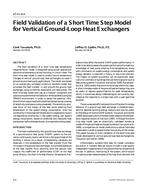This study numerically examines the effectiveness of an expedient intervention to provide surge airborne-isolation capacity and health-care worker (HCW) protection during epidemics such as pandemic flu. The intervention pairs a portable ventilated headboard with a High Efficiency Particulate Air (HEPA) filter/fan system. Airborne droplet nuclei were theoretically generated via a patient cough in a traditional hospital patient room. Room airflow patterns were modeled by solving the Reynolds-Averaged Navier-Stokes equations along with the continuity and energy equations. The Lagrangian discrete-phase model in the finite-volume solver ANSYS Fluent 14 was used to track the dispersal of an "infectious aerosol" originating from the patient cough. The study examined five different test configurations, and tracked the aerosol for 35 seconds following the cough. Without the intervention in the room, the HCW was exposed to the cough aerosol which also approached the HVAC exhaust and room door within 35 seconds. The ventilated headboard, in the operating position with its canopy extended and the HEPA system activated, was very effective, eliminating 99% of the patient-source aerosol within 20 seconds, and not allowing aerosol to escape the canopy or expose the HCW, thereby providing excellent HCW and patient-room protection. With the canopy retracted, the ventilated headboard lost its local control of the aerosol as the retracted canopy obstructed half of the headboard’s inlet area, and failed to prevent exposures to the HCW or to the vicinity of the room-entry door; however, the overall patient room would continue to benefit from the dilution filtration air cleaning provided by the HEPA system.
Citation: ASHRAE Papers: 2015 ASHRAE Annual Conference, Chicago, IL
Product Details
- Published:
- 2015
- Number of Pages:
- 8
- File Size:
- 1 file , 2.6 MB
- Product Code(s):
- D-CH-15-C017


